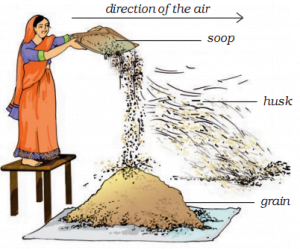Table of Contents
NCERT Class 6 Science Chapter, 5 Separation of Substances, Exercise question Solution
1. Why do we need to separate different components of a mixture? Give two examples.
Answer:
Sometimes a substance which we need comes mixed with other content. These substances may be unwanted, harmful or of other uses. For example, Pulses can have some stone as well which is unhealthy to eat. A fruit or spice may come with sticks which is of no use. Sometimes we need to separate items for the specific use. For example, we might need to separate ghee from milk for different purposes. So we separate them and use only the substance which we need.
2. What is winnowing? Where is it used?
Answer:

In winnowing, we use the wind to separate substances.
We use them in a mixture of substances where one is heavier than the other for example husk and wheat seed. Here wind carries the husk away while heavier grain accumulates at the bottom.
3. How will you separate husk or dirt particles from a given sample of pulses before cooking?
Answer: Decantation and sieving.
Husk float on the water so we will decant the mixture of pulse sample and water.
Dirt and pulse have differnt sizes. So if we now filter the sample with a sieve, we will be able to get the pulses free from the dust.
4. What is sieving? Where is it used?
Answer: Often we need to separate a mixture of different size particles. In such a case, we put the mixture in a sieve. Sieve consist of small pores. Here one component of mixture passes through the sieve while other components of bigger size get trapped in the sieve. For example, we separate wheat flour from husk or choker through sieving. Choker remains in the sieve while flour passes through the sieve and settle in the pot.
5. How will you separate sand and water from their mixture?
Answer: Sedimentation and Decantation.
Sand is insoluble in water. We will allow the sand to settle on the bottom with time. After that, we can decant water into another glass or bottle.
Alternatively, for higher purity, we can use a filtration technique using filter paper. Filter paper has tiny pores. These pores allow water to pass but not the sand.
6. Is it possible to separate sugar mixed with wheat flour? If yes, how will you do it?
Answer: Sieving.
We can separate sugar from wheat flour like we separate choker from wheat flour. Sugar has a size bigger than wheat flour. While sieving sugar will remain on the sieve while flour will pass to the pot.
7. How would you obtain clear water from a sample of muddy water?
Answer: By using filter water we can get clear water from the sample of muddy water.
Alternatively, through evaporation and condensation, we can get high-quality clean water.
8. Fill up the blanks
(a) The method of separating seeds of paddy from its stalks is called _______.
(b) When milk, cooled after boiling, is poured onto a piece of cloth the cream
(malai) is left behind on it. This process of separating cream from milk is an
example of _______.
(c) Salt is obtained from seawater by the process of _______.
(d) Impurities settled at the bottom when muddy water was kept overnight in a
bucket. The clear water was then poured off from the top. The process of
separation used in this example is called _______.
Answer: (a)Thrasing, (b)Filtration, (c)Evaporation, (d)Decantation.
9. True or false?
(a) A mixture of milk and water can be separated by filtration.
(b) A mixture of powdered salt and sugar can be separated by the process of
winnowing.
(c) Separation of sugar from tea can be done with filtration.
(d) Grain and husk can be separated from the process of decantation.
Answer: (a) False, (b) False, (c) False, (d) False.
10. Lemonade is prepared by mixing lemon juice and sugar in water. You wish to add ice to cool it. Should you add ice to the lemonade before or after dissolving sugar? In which case would it be possible to dissolve more sugar?
Answer: Sugar dissolves fastly in hot water than cold water. So if we add sugar in water before adding ice, it will dissolve fast. While if we add sugar after adding ice, the temperature of the water will be low so sugar will dissolve late.
Read Also: Class 6 Chapter 5 Activity Explanation.
Reference: NCERT class 6 chapter 5